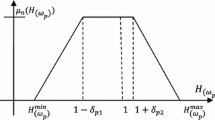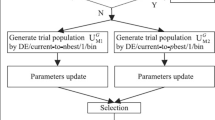Abstract
This paper proposes a hybrid optimization algorithm named as BBO–PSO, which is a combination of biogeography-based optimization (BBO) and particle swarm optimization (PSO). In BBO–PSO, the whole population will be split into several subgroups and BBO is employed for local search in each subgroup independently to achieve the different local optima while PSO is employed for global search based on the local optima to achieve the global optimum. The test results on the benchmark functions show that BBO–PSO has powerful search ability with great robustness. Furthermore, the proposed algorithm is applied to the design of the 2-D IIR digital filters and the simulation results show that it outperforms the existing methods on this problem.



Similar content being viewed by others
References
Chan, T. S., & Kumar, A. (2012). Reliable ear identification using 2-D quadrature filters. Pattern Recognition Letters, 33, 1870–1881.
Cui, Z. H. (2011). Social emotional optimization algorithm. Bei Jing: Publishing House of Electronics Industry.
Daniel, M., & Willsky, A. (1997). Efficient implementations of 2-D noncausal IIR filters. IEEE Transactions on Circuits and Systems, 44, 549–563.
Deb, K. (2010). An efficient constraint handling method for genetic algorithms. Computer Methods in Applied Mechanics and Engineering, 186(2–4), 311–338.
Guo, W. A., Li, W. Z., Zhang, Q., Wang, L., Wu, Q. D., & Ren, H. L. (2014). Biogeography-based particle swarm optimization with fuzzy elitism and its applications to constrained engineering problems. Engineering Optimization, 46(11), 1465–1484.
Hua, J. Y., Kuang, W. K., Gao, Z., Meng, L. M., & Xu, Z. J. (2014). Image denoising using 2-D FIR filters designed with DEPSO. Multimedia Tools and Applications, 69(1), 157–169.
Hum, S. V., Madanayake, H. L. P. A., & Bruton, L. T. (2009). UWB beamforming using 2-D beam digital filters. IEEE Transactions on Antennas and Propagation, 57(3), 804–807.
Kaczorek, T. (1985). Two-dimensional linear systems. Berlin: Springer.
Kennedy, J. & Eberhart, R. (1995). Particle swarm optimization. In Proceedings of 1995 IEEE International Conference on Neural Networks, (pp. 1942–1948). Perth, Australia.
Kumar, R., & Kumar, A. (2010). Design of two-dimensional infinite impulse response recursive filters using hybrid multiagent particle swarm optimization. Applied Artificial Intelligence, 24, 295–312.
Laasko, T., & Ovaska, S. (1994). Design and implementation of efficient IIR notch filters with quantization error feedback. IEEE Transactions on Instrumentation and Measurement, 43, 449–456.
Lu, W. S., & Antoniou, A. (1992). Two-dimensional digital filters. New York: Marcel Dekker.
Ma, H. P., & Simon, D. (2011). Blended biogeography-based optimization for constrained optimization. Engineering Applications of Artificial Intelligence, 24, 517–525.
Maria, G. A., & Fahmy, M. M. (1974). An lp design technique for two-dimensional digital recursive filters. IEEE Transactions on Acoustics, Speech, and Signal Processing, 22, 15–21.
Mastorakis, N. E., Gonos, I. F., & Swamy, M. N. S. (2003). Design of two-dimensional recursive filters using genetic algorithms. IEEE Transactions on Circuits and Systems, 50(5), 634–639.
Mladenov, V. M., & Mastorakis, N. E. (2001). Design of two-dimensional recursive filters by using neural networks. IEEE Transactions on Neural Networks, 12(3), 585–590.
Niknam, T., & Farsani, E. A. (2010). A hybrid self-adaptive particle swarm optimization and modified shuffled frog leaping algorithm for distribution feeder reconfiguration. Applied Artificial Intelligence, 23, 1340–1349.
Simon, D. (2008). Biogeography-based optimization. IEEE Transactions on Evolutionary Computation, 12(6), 702–713.
Tsai, J. T., Ho, W. H., & Chou, J. H. (2009). Design of two-dimensional IIR digital structure-specified filters by using an improved genetic algorithm. Expert Systems with Applications, 36, 6928–6934.
Tzafestas, S. G. (1986). Multidimensional systems, techniques and applications. New York: Marcel Dekker.
Wu, C. W. (1991). Bit-level pipelined 2-D digital filters for real-time image processing. IEEE Transactions on Circuits and Systems for Video Technology, 1(1), 22–34.
Author information
Authors and Affiliations
Corresponding author
Additional information
This work was partly supported by the National Natural Science Foundation of China (No. 61104122), the Fundamental Research Funds for the Central Universities (lzujbky-2016), and the Japan Society for the Promotion of Science (JSPS.KAKENHI15K06072).
Rights and permissions
About this article
Cite this article
Lv, C., Yan, S., Cheng, G. et al. Design of two-dimensional IIR digital filters by using a novel hybrid optimization algorithm. Multidim Syst Sign Process 28, 1267–1281 (2017). https://doi.org/10.1007/s11045-016-0397-0
Received:
Revised:
Accepted:
Published:
Issue Date:
DOI: https://doi.org/10.1007/s11045-016-0397-0




